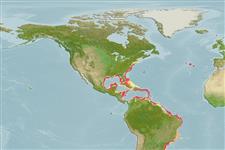>
Carangiformes (Jacks) >
Carangidae (Jacks and pompanos) > Naucratinae
Etymology: Seriola: Latin word diminutive with the meaning of a large earthenware pot (Ref. 45335).
More on author: Bloch.
Environment: milieu / climate zone / depth range / distribution range
Ecologia
marinhas bentopelágico; intervalo de profundidade 55 - 348 m (Ref. 51158). Subtropical; 43°N - 30°S, 98°W - 15°W
Western Atlantic: Massachusetts, USA to Brazil. Eastern Atlantic: Madeira (Ref. 7097); Turkey (Ref. 95646); eastern Atlantic distribution is uncertain due to past confusion with Seriola carpenteri.
Tamanho / Peso / Idade
Maturity: Lm ? range ? - ? cm
Max length : 67.5 cm FL macho/indeterminado; (Ref. 26340); common length : 50.0 cm TL macho/indeterminado; (Ref. 5217); peso máx. publicado: 4.6 kg (Ref. 3195)
Espinhos dorsais (total) : 9; Raios dorsais (total) : 28 - 33; Raios anais : 17 - 20.
Adults are benthopelagic near the coasts (Ref. 5217). Smaller juveniles epipelagic in oceanic or offshore neritic waters. Adults feed on squids and fishes (Ref. 4233). Eggs are pelagic (Ref. 4233).
Ciclo de vida ou comportamento de acasalamento
Maturidade | Reprodução | Desova | Ovos | Fecundidade | Larvas
Smith-Vaniz, W.F., J.-C. Quéro and M. Desoutter, 1990. Carangidae. p. 729-755. In J.C. Quero, J.C. Hureau, C. Karrer, A. Post and L. Saldanha (eds.) Check-list of the fishes of the eastern tropical Atlantic (CLOFETA). JNICT, Lisbon; SEI, Paris; and UNESCO, Paris. Vol. 2. (Ref. 7097)
Status na Lista Vermelha da UICN (Ref. 130435: Version 2024-2)
Ameaça para os humanos
Reports of ciguatera poisoning (Ref. 30911)
Uso pelos humanos
Pescarias: pesca de subsistência; peixe esportivo: sim
Ferramentas
Relatórios especiais
Baixar XML
Fontes da internet
Estimates based on models
Preferred temperature (Ref.
123201): 17.7 - 26.5, mean 23.3 °C (based on 70 cells).
Índice de diversidade filogenética (Ref.
82804): PD
50 = 0.5020 [Uniqueness, from 0.5 = low to 2.0 = high].
Bayesian length-weight: a=0.01585 (0.00893 - 0.02811), b=2.94 (2.78 - 3.10), in cm total length, based on LWR estimates for this species & (Sub)family-body (Ref.
93245).
Nível Trófico (Ref.
69278): 4.6 ±0.57 se; based on food items.
Resiliência (Ref.
120179): médio(a), tempo mínimo de duplicação da população 1,4 - 4,4 anos (Preliminary K or Fecundity.).
Fishing Vulnerability (Ref.
59153): Moderate to high vulnerability (50 of 100).
Nutrients (Ref.
124155): Calcium = 52.1 [31.4, 109.6] mg/100g; Iron = 1.09 [0.60, 1.99] mg/100g; Protein = 18.2 [15.3, 21.1] %; Omega3 = 0.39 [0.24, 0.65] g/100g; Selenium = 31.8 [16.6, 61.7] μg/100g; VitaminA = 56.6 [7.4, 416.2] μg/100g; Zinc = 0.54 [0.38, 0.78] mg/100g (wet weight);
